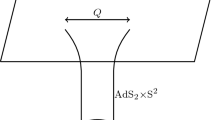Abstract
In this paper, we study the holographic complexity of rotating Banados–Teitelboim–Zanelli black hole in the context of the ”Complexity-Action” conjecture and in the framework of General Minimal Massive Gravity (GMMG) and Exotic General Massive Gravity (EGMG). In addition, we investigate the action growth rate based on two kinds of conserved charges of the theories and examine the Lloyd bound on the rate of quantum computation. Then, we study the complexity of the formation of black holes in both theories.

Similar content being viewed by others
Data availability
Data sharing not applicable to this article as no datasets were generated or analyzed during the current study.
Notes
We note that our results for TMG do not agree with those obtained previously [12] for TMG.
References
Susskind, L.: Fortsch. Phys. 64, 24–43 (2016). arXiv:1403.5695 [hep-th]
Stanford, D., Susskind, L.: Phys. Rev. D 90(12), 126007 (2014). arXiv:1406.2678 [hep-th]
Brown, A.R., Roberts, D.A., Susskind, L., Swingle, B., Zhao, Y.: Phys. Rev. Lett. 116(19), 191301 (2016). arXiv:1509.07876 [hep-th]
Brown, A.R., Roberts, D.A., Susskind, L., Swingle, B., Zhao, Y.: Phys. Rev. D 93(8), 086006 (2016). arXiv:1512.04993 [hep-th]
Couch, J., Fischler, W., Nguyen, P.H.: JHEP 03, 119 (2017). https://doi.org/10.1007/JHEP03(2017)119. arXiv:1610.02038 [hep-th]
Belin, A., Myers, R.C., Ruan, S.M., Sárosi, G., Speranza, A.J.: Phys. Rev. Lett. 128, 8, 081602 (2022). https://doi.org/10.1103/PhysRevLett.128.081602. arXiv:2111.02429 [hep-th]
Omidi, F.: arXiv:2207.05287 [hep-th]
Lloyd, S.: Nature 406, 1047 (2000)
Cai, R.G., Ruan, S.M., Wang, S.J., Yang, R.Q., Peng, R.H.: JHEP 09, 161 (2016). arXiv:1606.08307 [gr-qc]
Huang, H., Feng, X.H., Lu, H.: Phys. Lett. B 769, 357–361 (2017). arXiv:1611.02321 [hep-th]
Asl, B.B., Hendi, S.H., Sajadi, S.N.: Phys. Rev. D 104(10), 104034 (2021). arXiv:2102.12515 [gr-qc]
Ghodrati, M.: Phys. Rev. D 96(10), 106020 (2017). arXiv:1708.07981 [hep-th]
Alishahiha, M., Faraji Astaneh, A., Naseh, A., Vahidinia, M.H.: JHEP 05, 009 (2017). arXiv:1702.06796 [hep-th]
Auzzi, R., Baiguera, S., Nardelli, G.: JHEP 06, 063 (2018). arXiv:1804.07521 [hep-th]
Özkan, M., Pang, Y., Townsend, P.K.: JHEP 08, 035 (2018). arXiv:1806.04179 [hep-th]
Setare, M.R.: Nucl. Phys. B 898, 259–275 (2015). arXiv:1412.2151 [hep-th]
Banados, M., Teitelboim, C., Zanelli, J.: Phys. Rev. Lett. 69, 1849–1851 (1992). arXiv:hep-th/9204099 [hep-th]
Setare, M.R., Adami, H.: Phys. Lett. B 760, 411–416 (2016). arXiv:1606.02273 [hep-th]
Strominger, A.: JHEP 02, 009 (1998). arXiv:hep-th/9712251 [hep-th]
Setare, M.R., Adami, H.: Phys. Lett. B 744, 280–283 (2015). arXiv:1504.01660 [gr-qc]
Bergshoeff, E.A., Merbis, W., Townsend, P.K.: Class. Quant. Grav. 37(3), 035003 (2020). arXiv:1909.11743 [hep-th]
Mann, R.B., Oliva, J., Sajadi, S.N.: JHEP 05, 131 (2019). arXiv:1812.09525 [gr-qc]
Giribet, G., Oliva, J.: Phys. Rev. D 99(6), 064021 (2019). arXiv:1901.08457 [hep-th]
Setare, M.R., Oliva, J., Sajadi, S.N.: arXiv:2106.12040 [hep-th]
Chapman, S., Marrochio, H., Myers, R.C.: JHEP 01, 062 (2017). https://doi.org/10.1007/JHEP01(2017)062. arXiv:1610.08063 [hep-th]
Auzzi, R., Baiguera, S., Grassi, M., Nardelli, G., Zenoni, N.: JHEP 09, 013 (2018). https://doi.org/10.1007/JHEP09(2018)013. arXiv:1806.06216 [hep-th]
Acknowledgements
SNS would like to thank F. Omidi for his fruitful comments on the paper. The authors also acknowledge the support of Kurdistan University.
Author information
Authors and Affiliations
Corresponding author
Additional information
Publisher's Note
Springer Nature remains neutral with regard to jurisdictional claims in published maps and institutional affiliations.
Appendix: Boundary term
Appendix: Boundary term
The action principle can be written in a CS−like form
The variation of the Lagrangian can be given as
where \(\phi _{i}\) indicates all the fields (metric and matter) which solve their corresponding equations of motion \(E_{\phi _{i}}\) and the presymplectic potential \(\Theta \) is defined up to add some ambiguities related to the corner terms in the action principle. For the CS—like theory of gravity, the presymplectic form is given by [18]
where the constant \(g_{rs}\) can be interpreted as a symmetric tensor and for GMMG is given by [21]
By considering \(u=\lbrace e,\omega ,h,f\rbrace \), one can obtain the presymplectic form of GMMG
and considering \(u=\lbrace e,\omega ,h,f\rbrace \), one can obtain the presymplectic form of EGMG
where we have used
Then by removing \(\delta \) from the \(\Theta \) one can achieve the Eqs. (10) and (41) for boundary terms.
Rights and permissions
Springer Nature or its licensor (e.g. a society or other partner) holds exclusive rights to this article under a publishing agreement with the author(s) or other rightsholder(s); author self-archiving of the accepted manuscript version of this article is solely governed by the terms of such publishing agreement and applicable law.
About this article
Cite this article
Sajadi, S.N., Setare, M.R. Action-complexity in GMMG and EGMG. Gen Relativ Gravit 54, 157 (2022). https://doi.org/10.1007/s10714-022-03044-w
Received:
Accepted:
Published:
DOI: https://doi.org/10.1007/s10714-022-03044-w



